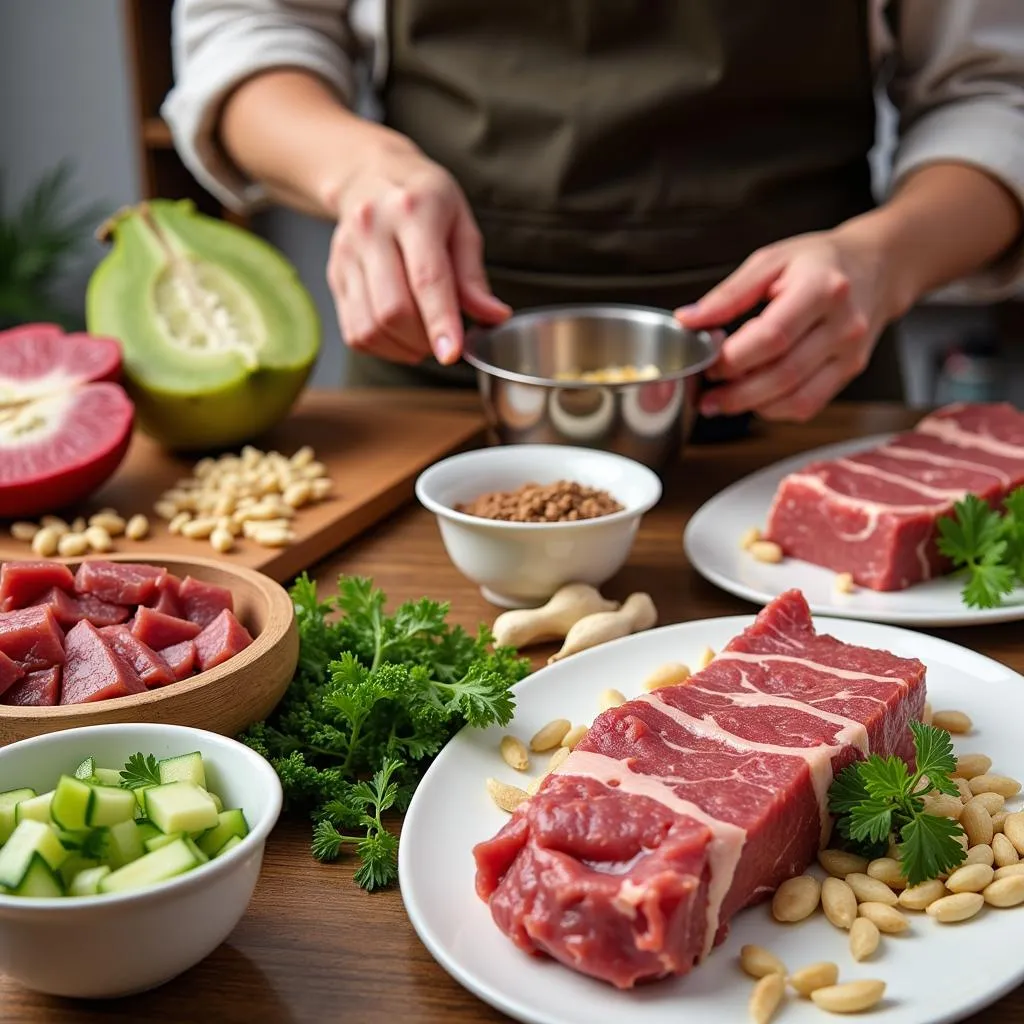Open Raw Dog Food is gaining popularity amongst pet parents looking for a more natural and potentially healthier diet for their furry friends. But what exactly is it, and is it the right choice for your canine companion?
Understanding Open Raw Dog Food
Open raw dog food, unlike commercially produced raw food, isn’t pre-packaged and requires more hands-on preparation from the owner. It generally consists of fresh, uncooked ingredients like muscle meat, bones, organs, fruits, and vegetables. Think of it as cooking a wholesome meal for yourself, but for your dog!
The Appeal of Feeding Raw
Proponents of raw feeding, particularly the open raw method, often cite several benefits:
- Improved Digestion: Raw food is believed to be closer to a dog’s ancestral diet, potentially aiding in better digestion.
- Shinier Coat, Healthier Skin: Many owners report noticeable improvements in their dog’s coat and skin health after switching to a raw diet.
- Increased Energy Levels: Some believe that a raw diet provides dogs with more natural energy, resulting in increased vitality.
- Dental Health: Chewing on raw meaty bones can help scrape away plaque and tartar, contributing to better dental hygiene.
 Dog Enjoying Raw Food
Dog Enjoying Raw Food
Navigating the World of Open Raw Dog Food
Transitioning your dog to an open raw diet requires careful consideration and planning. Here’s a step-by-step guide:
- Consult Your Veterinarian: Before making any dietary changes, speak with your veterinarian. They can assess your dog’s specific needs and rule out any potential health concerns.
- Source High-Quality Ingredients: The foundation of a healthy open raw diet is high-quality, human-grade ingredients. This means sourcing meat from reputable butchers and using fresh, organic fruits and vegetables.
- Understand the Balancing Act: Open raw feeding requires a good understanding of canine nutrition. Dogs need a specific balance of protein, fat, vitamins, and minerals. Consult resources or work with a canine nutritionist to create a balanced meal plan.
- Introduce Gradually: Don’t switch your dog to a raw diet overnight. Gradually introduce raw food into their existing diet over a week or two, monitoring for any digestive issues.
- Maintain Hygiene: Since you’re dealing with raw meat, maintaining hygiene is crucial. Wash your hands thoroughly, sanitize surfaces, and wash your dog’s bowls after every meal.
 Preparing Open Raw Dog Food
Preparing Open Raw Dog Food
Addressing Common Concerns
Open raw feeding, while gaining traction, comes with its share of concerns:
Is it Safe?
Safety is a top concern when it comes to handling raw meat. However, by following strict hygiene practices and sourcing ingredients responsibly, risks can be minimized.
Is it Expensive?
Open raw feeding can be more expensive than commercial kibble, especially if you’re sourcing premium ingredients. However, many owners find the potential health benefits justify the cost.
Is it Time-Consuming?
Yes, preparing open raw meals takes more time and effort than scooping kibble. You’ll be spending time sourcing, preparing, and portioning meals.
Open Raw Dog Food: Is It Right For You?
Open raw feeding can be a rewarding experience, providing your dog with a natural and potentially healthier diet. However, it requires commitment, knowledge, and careful planning. “Choosing the right diet for your dog is an individual decision,” says Dr. Sarah Williams, a veterinary nutritionist. “Factors like your dog’s age, breed, activity level, and any underlying health conditions should be considered.”
Ultimately, the decision to switch to open raw dog food is a personal one. Weigh the pros and cons, do your research, and consult with your veterinarian to make an informed choice for your furry friend.
FAQs about Open Raw Dog Food
1. What if my dog doesn’t like the taste of raw food?
Start by mixing a small amount of raw food with their regular food. Gradually increase the ratio of raw food as they get accustomed to the taste.
2. Can puppies eat open raw food?
Puppies have different nutritional needs than adult dogs. It’s best to consult with your vet before starting a puppy on an open raw diet.
3. How do I store open raw dog food?
Store prepared meals in airtight containers in the refrigerator for up to 3 days. You can freeze portions for longer storage.
4. Where can I find recipes for open raw dog food?
There are many online resources and books dedicated to open raw feeding. Look for recipes that are formulated by certified canine nutritionists.
5. My dog has allergies. Can I still feed an open raw diet?
Yes, an open raw diet can be customized to accommodate allergies. Work with your vet or a canine nutritionist to identify and avoid specific ingredients.
Need Help with Your Dog’s Diet?
We understand choosing the right food for your pet is important. To learn more about Dr. Gary’s Puppy Food, Dr. Ross Dog Food, or other options, contact us at 02437655121, email [email protected], or visit us at 3PGH+8R9, ĐT70A, thôn Trung, Bắc Từ Liêm, Hà Nội, Việt Nam. Our team is available 24/7 to assist you. You can also check out our other helpful articles on Fast Food Iceland and N & D Dog Food for more information.